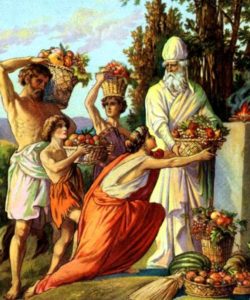Today we celebrate Yom Ha’Atzmaut, the modern State of Israel’s Independence Day, which immediately follows Yom HaZikaron, when we commemorate those who have given their lives for Israel. Each one of those lost is an indescribable tragedy. Though Israel has won the majority of its wars, the price has been devastatingly high. We know that what happens in this material world is often just a reflection of higher realities occurring in the spiritual worlds. With that in mind, what can we all do spiritually to affect the worlds above, in order to strengthen Israel militarily here below? The Torah gives us four major tools that a Jew can do that will go a long way in boosting Israel’s might and, God willing, reducing casualties in war.
The first of these tools comes from this week’s parasha, Acharei Mot, which spends many lines describing the Yom Kippur service. Commenting on one of the verses here (Leviticus 16:12), the Ba’al HaTurim (Rabbi Yakov ben Asher, 1269-1340) points out that “in the merit of the Yom Kippur service, [the Israelites] would win wars.” Although we do not have a Temple today to fulfill all of the services, nonetheless our heartfelt prayers and repentance on Yom Kippur affect a change in the Heavens that result in Israel becoming militarily stronger and victorious in war.
We see a perfect demonstration of this in the 1973 Yom Kippur War, when Israel was surprise-attacked by its Arab neighbours, totally unprepared and with most of its soldiers in the synagogues. The war initially went very badly, and military analysts even predicted the impending demise of Israel. Yet, things turned around quickly, and just two weeks later the war ended with a resounding victory for Israel. Henceforth, the Arabs never tried another invasion, and Egypt—the leading power in the Arab world—gave up any goals of destroying Israel, instead pursuing peace. The Arab armies thought that by attacking Israel on Yom Kippur they had a big advantage. The reality was the exact opposite! In the merit of Yom Kippur, Israel won the war and permanently altered the geopolitical landscape in the Middle East.

Six years earlier, before the similarly miraculous Six-Day War, the Lubavitcher Rebbe instituted another campaign to strengthen Israel militarily: encouraging the donning of tefillin. Ever since, Chabadnikim around the world go to street corners, supermarkets, bus stops and other public places to encourage Jewish men to wrap. Various reasons have been given for why the Rebbe chose tefillin specifically as a way to strengthen Israel. The main one is based on a passage in the Talmud (Rosh Hashanah 17a). Here, the Sages discuss an End of Days prophecy in Zechariah which states a third of the population will be purified “by fire”. The Sages say these are the rebellious people who sinned with their bodies. The Talmud further defines that when it comes to the gentiles, the ones who sinned with their bodies are those who engaged in sexual sins. When it comes to Jews, however, it refers to those who never put tefillin on their bodies!
Based on this, the Rebbe saw that there is tremendous merit in donning tefillin, and puts a Jew into a wholly different spiritual category once he has done so, even just once. Moreover, since the verse in Zechariah is talking about an End of Days prophecy about the final apocalyptic war before Mashiach’s arrival, the Rebbe saw further significance to our day and age, hence the message that we should increase the observance of tefillin. Indeed, the tefillin campaign was a huge success, as was Israel’s subsequent Six-Day War, with huge implications for the coming of Mashiach, since this is when Jerusalem and the Jewish heartland of Judea and Samaria were reclaimed and liberated.
I believe there is another proof for the tefillin-military might connection: In Berakhot 57a, we read that a person who dreams of himself in tefillin should expect greatness. This is based on Deuteronomy 28:10 which reads: “And all the peoples of the earth shall see that the name of God is called upon you; and they shall be afraid of you.” The Sages ask: what does it mean to have the “name of God” upon you? It means putting on tefillin, since this is when God’s Name is literally wrapped upon a person’s body! And, when the gentiles see a Jew in tefillin, it inspires a sense of awe and fear among them. So, just as Deuteronomy promises, when the Jewish nation carefully and diligently dons tefillin, it will inspire fear in our enemies.
Another segulah for reducing Israel’s casualties on the frontlines and beyond is the mitzvah of charity. This one is well-known and needs little elaboration, since the Tanakh emphatically states that tzedakah tatzil mimavet, “charity saves from death” (Proverbs 10:2). As explained in detail elsewhere (see ‘How Charity Can Save Your Life’ in Garments of Light, Volume One), providing a financial contribution to a worthy cause affects a change in the Heavens that can tear up a decree hanging over a person’s soul. This is because the money one earns is tied directly to the exertion they put in to earn that money, since a person invests their time, energy, and soul into their work. The Torah tells us that giving even a half-shekel serves as kofer nefesh, an atonement for the soul (Exodus 30:12). There is a beautiful mathematical proof to this in that the words shekel (שקל) and nefesh (נפש) have the same numerical value (430)!
Finally, the Torah states that if we are worthy, “Five of you shall chase away a hundred, and a hundred of you shall chase away ten thousand; your enemies shall fall before you by the sword.” (Leviticus 26:8) A classic question here is regarding the ratios: five chasing away a hundred is a ratio of 1 to 20, but a hundred chasing away ten thousand is a ratio of 1 to 100! What we can learn from this is that the more Jews are united and fighting together, the stronger we become. That strength does not just grow linearly, but exponentially! The message is that we must all be united. Instead of sinat hinam, baseless hatred and enmity, we must have ahavat hinam, baseless love and unity. This is our greatest source of strength.
Putting it all together, we have four key tools to increase Israel’s military and physical might: Yom Kippur, tefillin, tzedakah, and ahava. Amazingly, if we take the initials* of these terms (י כ ת צ א), they spell out כי תצא, as in כִּֽי־תֵצֵ֥א לַמִּלְחָמָ֖ה עַל־אֹיְבֶ֑יךָ וּנְתָנ֞וֹ יְהֹוָ֧ה אֱלֹהֶ֛יךָ בְּיָדֶ֖ךָ, “When you go out to war against your enemies and God will deliver them into your hand…” (Deuteronomy 21:10) There is no better proof than this that if we increase our observance of these crucial mitzvot as a nation, we will undoubtedly be invincible, and God will deliver all of our enemies into our hands.
Yom Ha’Atzmaut Sameach!
*If we take only the first initials of the four mitzvot above (without the kaf of kippur), we have יתצ״א, which carries a value of 501. This is a very significant number, too. At the Pesach seder, we group the Ten Plagues by their initials and recite דצ״ך עד״ש באח״ב. The great kabbalist Rav Shimshon of Ostropoli (d. 1648) taught that the value of this phrase is 501, equivalent to an angel named תק״א that facilitated the plagues and punished the enemies of Israel. Additionally, this is reminiscent of the “Angel of God” that struck down the Assyrian camp of 185,000 soldiers to protect Jerusalem in the time of King Hezekiah (II Kings 19:35).
From the Archives: The Kabbalah of Yom Ha’Atzmaut


